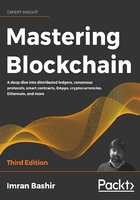
Routes to decentralization
There are systems that pre-date blockchain and Bitcoin, including BitTorrent and the Gnutella file-sharing system, which to a certain degree could be classified as decentralized, but due to a lack of any incentivization mechanism, participation from the community gradually decreased. There wasn't any incentive to keep the users interested in participating in the growth of the network. With the advent of blockchain technology, many initiatives are being taken to leverage this new technology to achieve decentralization. The Bitcoin blockchain is typically the first choice for many, as it has proven to be the most resilient and secure blockchain and has a market cap of nearly $166 billion at the time of writing. Alternatively, other blockchains, such as Ethereum, serve as the tool of choice for many developers for building decentralized applications. Compared to Bitcoin, Ethereum has become a more prominent choice because of the flexibility it allows for programming any business logic into the blockchain by using smart contracts.
How to decentralize
Arvind Narayanan and others have proposed a framework in their book Bitcoin and Cryptocurrency Technologies that can be used to evaluate the decentralization requirements of a variety of issues in the context of blockchain technology. The framework raises four questions whose answers provide a clear understanding of how a system can be decentralized:
- What is being decentralized?
- What level of decentralization is required?
- What blockchain is used?
- What security mechanism is used?
The first question simply asks you to identify what system is being decentralized. This can be any system, such as an identity system or a trading system.
The second question asks you to specify the level of decentralization required by examining the scale of decentralization, as discussed earlier. It can be full disintermediation or partial disintermediation.
The third question asks developers to determine which blockchain is suitable for a particular application. It can be Bitcoin blockchain, Ethereum blockchain, or any other blockchain that is deemed fit for the specific application.
Finally, a fundamental question that needs to be addressed is how the security of a decentralized system will be guaranteed. For example, the security mechanism can be atomicity-based, where either the transaction executes in full or does not execute at all. This deterministic approach ensures the integrity of the system. Other mechanisms may include one based on reputation, which allows for varying degrees of trust in a system.
In the following section, let's evaluate a money transfer system as an example of an application selected to be decentralized.
Decentralization framework example
The four questions discussed previously are used to evaluate the decentralization requirements of this application. The answers to these questions are as follows:
- Money transfer system
- Disintermediation
- Bitcoin
- Atomicity
The responses indicate that the money transfer system can be decentralized by removing the intermediary, implemented on the Bitcoin blockchain, and that a security guarantee will be provided via atomicity. Atomicity will ensure that transactions execute successfully in full or do not execute at all. We have chosen the Bitcoin blockchain because it is the longest established blockchain and has stood the test of time.
Similarly, this framework can be used for any other system that needs to be evaluated in terms of decentralization. The answers to these four simple questions help clarify what approach to take to decentralize the system.
To achieve complete decentralization, it is necessary that the environment around the blockchain also be decentralized. We'll look at the full ecosystem of decentralization next.